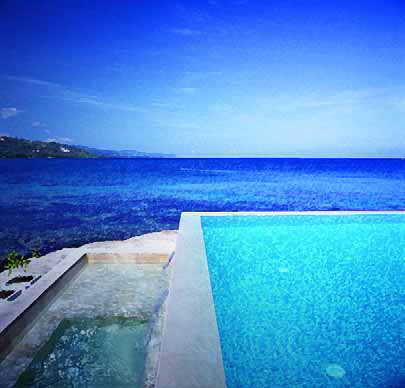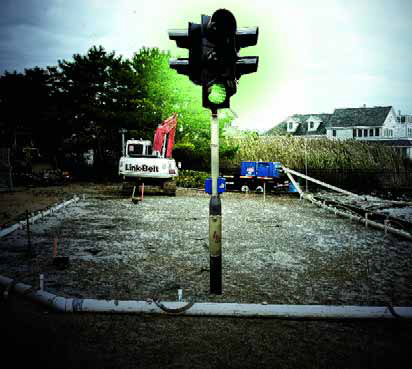construction
When you work with any type of concrete, there are right and wrong ways to do things - basic issues of workmanship that really do determine whether a structure will be reliable or not. In the case of swimming pools and spas built using pneumatically applied concrete - either shotcrete or gunite - there's a presumption in structural design that the concrete will cure to the strength specified, which, in the case of pools and spas, is typically 2,000 pounds per square inch. If that's not the case, these structures do not meet their specifications and may be subject to failure as a result. To achieve that desired level of strength, the concrete must be
It certainly doesn't happen very often, but sometimes the addition of a watershape can completely redefine the way a property is perceived. In the case seen here, a nine-acre estate in the mountains above of Malibu, Calif., was zoned for agriculture. The owner's intention in buying it was quite appropriate: He wanted to turn it into a working vineyard brought to life visually by a big stream, pond and waterfall system. Once the watershape took form, however, the owner was so inspired by what he saw that his vision for the property changed and he recast the place as a venue for weddings and other events that would be enhanced by the bucolic, utterly romantic surroundings. In a very direct way, in other words, the watershapes served to increase both the aesthetic and financial value of the property. I'm a romantic at heart, so the notion that the work on display here will be a backdrop for special, memorable occasions has made the big, complicated project even more
Water is one of the few artistic media that has the ability to define the architecture of human emotion. In all its various forms, it has affected us in profound ways since the dawn of our species, generating powerful feelings and the sense that we are somehow transformed when we're in its presence. As watershapers, we have an ability to use that long anthropological and cultural heritage to our advantage and can actually change the world: The spaces we create will, if done well, generate experiences so powerful that all who enter these environments will forever be changed by the encounter. I see this as both a wonderful opportunity and a solemn obligation. We can take the rich history of water and all its cultural reverberations and essentially use this symphony of tradition and creative impetuosity to compose new experiences for everyone who sees our work. If it's our intention to change the world for the better - something I personally have always held in mind - we do our best when we base our work on traditions assembled throughout human history. Working in that context, we not only gain access to the insights of the geniuses who have gone before us but also
In a couple of my recent "Details," I've discussed the early stages of a wonderful project located on the waterfront of Long Beach Island, N.J. As is the case with many top-level jobs, this one required a great deal of work in the early going to make sure we were set up for complete success once the installation process was under way and the pool, spa and surrounding structures began to come together. Although the pool in question is a simple rectangle designed to function mainly as a subtle and elegant reflective surface, there are certain features within the "shape" of the shell that make it something special - and particularly relevant to how the clients
It's easy to talk about watershapes and the creative and business philosophies that drive success, but to borrow a phrase: The proof is in the pool. In other words, it's one thing to talk about doing a good job, but it's another to step up and do it. The dynamics of that success are unusually complex when you participate in a project as the member of a team. As a case in point, I'll return to a semi-public watershape I first mentioned in my March 2006 column: It's now complete and is one of which I'm particularly proud. Located in Jamaica near Montego Bay at a property known as the Round Hill Hotel & Villas, it was a special sort of commercial project in that, being built outside the United States, it wasn't subject to
Sometimes the simple things make all the difference between success and failure. For all of the high-flown conceptualizing that drives much of what so many watershapers do these days, there's no escaping the need for attention to
In the design and construction of any watershape, there are a number of points in the process where you can see big differences between the way custom designers and contractors do things and the way production/volume-oriented companies go about their business. From first conversations with clients straight through to commissioning the system and turning it over to the homeowners, it's easy to spot these distinctions and define key differences. To illustrate just one of these areas, let me discuss the case of the permitting phase for the project on Long Beach Island, N.J., I began covering two issues ago. What's involved here is a cluster of issues that occurred more or less simultaneously in the project's early going. The elements of this cluster may not seem directly related to one another, but
In most projects, great work requires the watershaper's personal understanding of who the clients really are, deep down. That doesn't mean we have to become our clients' best friends or marry into their families. Rather, creating watershapes at the highest level involves a different kind of relationship, one in which a shared vocabulary and common vision develop through discussions of water, stone, art, plants and the orchestration and staging of experiences that will occur in given spaces. Take the project covered here as an example: The scope of the work, an unlimited budget and a mandate for the highest possible levels of quality were enough on their own to force us to explore the limits of our skills and creativity. More important from our perspective, however, is that we
In last month's "Detail," I discussed the beginning stages of a new project that has my partner Kevin Fleming and me pretty excited. At this point, the pool's been shot and we're moving along at a good pace. I'll pick up that project again in upcoming issues, but I've brought it up briefly here to launch into a discussion about something in our industry that mystifies me almost on a daily basis. So far, the work we've done on the oceanfront renovation project has been focused on a relatively narrow band of design considerations having to do with the watershape and its associated structures. This focus is
Contractors of all types are notorious for setting impossible-to-keep schedules, thereby disappointing clients and damaging their own credibility in the process. Sometimes, however, situations arise that require landshapers to shrink their established installation timetables, a necessity that will turn up the heat on even the most accomplished of contractors. For the project profiled in these pages, my clients had something come up that (from their perspective, anyway) necessitated completion of the project much earlier than anyone thought: They were expecting a baby and insisted that our delivery date should happen before theirs. The challenge we faced with the new timetable - just five months rather than the planned eight - was huge: It required truly constant interaction and communication with the clients and sub-contractors as well as intensive coordinating and expediting of a mind-boggling number of simultaneous processes - enough to drive us all crazy from time to time, but ultimately a






















